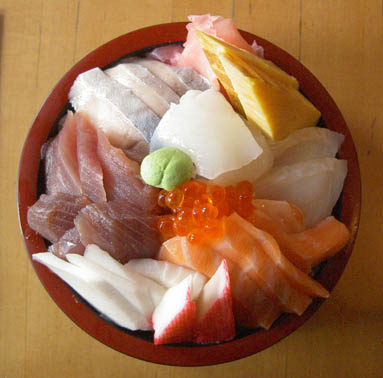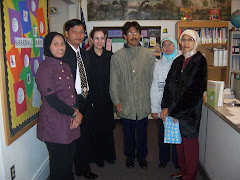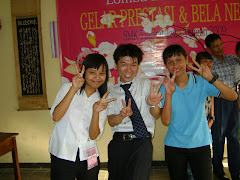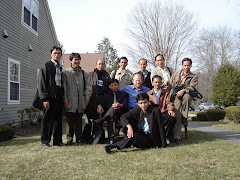Japanese Cuisine: Hina Matsuri Food
Hina Matsuri (雛祭り) is a doll festival in which multiple dolls are displayed and presented to young girls as gifts. This tradition goes back to the time when Japanese people believed that dolls had the power to contain evil spirits within the doll, so that the young girl would not be harmed by the evil spirit. In traditional times, when child mortaltity rates were high, parents believed that presenting these dolls would prevent illness and other misfortune from befalling the child. However, the dolls had to be taken down from display no longer than a week of the festival. The superstition is that the young girl will have difficulty getting married if the dolls are displayed in public for too long.
 One of the things I looked forward to as a young child was the food served at the Hina Matsuri (雛祭り) festival. Hishimochi (ひしもち) is a tri-colored rice cake in the shape of a diamond. The diamond shape of the cake is supposed to represent fertility. The usual colors for hishimochi (ひしもち) are pink, white and green. The pink dye comes from crushing plum flowers and the white dye derives from crushing water chestnuts. The green dye is made from shrubs.
One of the things I looked forward to as a young child was the food served at the Hina Matsuri (雛祭り) festival. Hishimochi (ひしもち) is a tri-colored rice cake in the shape of a diamond. The diamond shape of the cake is supposed to represent fertility. The usual colors for hishimochi (ひしもち) are pink, white and green. The pink dye comes from crushing plum flowers and the white dye derives from crushing water chestnuts. The green dye is made from shrubs.
 I’m a picky about sushi, but I happen to like the chirashizushi (ちらし寿司). Chirashizuki (ちらし寿司) literally means “scattered sushi”. It’s fast and easy to make. Just get some rice mixed with vinegar and sugar and mix in some vegetables. It’s not your typical sushi (すし) in the sense that you wrap the rice and vegetables in seaweed. Like the name implies, chirashizuki (ちらし寿司) is literally a bowl of rice with some raw fish and vegetables.
I’m a picky about sushi, but I happen to like the chirashizushi (ちらし寿司). Chirashizuki (ちらし寿司) literally means “scattered sushi”. It’s fast and easy to make. Just get some rice mixed with vinegar and sugar and mix in some vegetables. It’s not your typical sushi (すし) in the sense that you wrap the rice and vegetables in seaweed. Like the name implies, chirashizuki (ちらし寿司) is literally a bowl of rice with some raw fish and vegetables.
 For drinks, you’ll find people sipping shirozake (白酒), which is a sweet, white colored sake (酒). Shirozake (白酒) is made from malt rice and liquor. It’s really pulpy, so sometimes you’ll see people scoop it up with a scoop instead of drinking it. Shirozake (白酒) is meant to symbolize the desire for purity and health of the young girl. Of course, the child isn’t supposed to drink it, but the parents and grandparents often do so.
For drinks, you’ll find people sipping shirozake (白酒), which is a sweet, white colored sake (酒). Shirozake (白酒) is made from malt rice and liquor. It’s really pulpy, so sometimes you’ll see people scoop it up with a scoop instead of drinking it. Shirozake (白酒) is meant to symbolize the desire for purity and health of the young girl. Of course, the child isn’t supposed to drink it, but the parents and grandparents often do so.
I dedicate this post to all the young girls out there who are trying to reach their highest potential and fulfill their dreams. Keep at it or in Japanese, Ganbatte! (がんばって)
 The third platform contains five figures of musicians called go nin bayashi (
The third platform contains five figures of musicians called go nin bayashi ( The fourth platform contains two government officials. The minister of the right is called the udaijin (
The fourth platform contains two government officials. The minister of the right is called the udaijin ( The fifth platform is the funniest platform. (At least to me it is.) There are three samurai (さむらい) of various temperments in drinking. For example the sad samurai drinker is called nakijougo (
The fifth platform is the funniest platform. (At least to me it is.) There are three samurai (さむらい) of various temperments in drinking. For example the sad samurai drinker is called nakijougo ( The sixth platform contains various chests or storage boxes. For example there’s a nagamochi (
The sixth platform contains various chests or storage boxes. For example there’s a nagamochi ( The seventh platform contains a bunch of items used for transportation. For example there’s a palanquin called a gokago (
The seventh platform contains a bunch of items used for transportation. For example there’s a palanquin called a gokago (


 Around February 15th in the city of Kuromori (くろもり) in Yamagata (
Around February 15th in the city of Kuromori (くろもり) in Yamagata ( Everything about the Kuromori Kabuki (くろもりかぶき) festival depends on teamwork. The plays are performed outside with a stage constructed by the local residents of the town. These makeshift plays always have a hanamichi (花道). A hanamichi (花道) is a walkway that allows the actors to move through the audience. You can get a close up view of the actors and at the same time see their facial expressions. It allows the audience to connect with the actors that much more.
Everything about the Kuromori Kabuki (くろもりかぶき) festival depends on teamwork. The plays are performed outside with a stage constructed by the local residents of the town. These makeshift plays always have a hanamichi (花道). A hanamichi (花道) is a walkway that allows the actors to move through the audience. You can get a close up view of the actors and at the same time see their facial expressions. It allows the audience to connect with the actors that much more. The coolest part of the stage for me, is the mawari butai (まわりぶたい). A mawari butai (まわりぶたい) is a revolving stage that allows the scene of the play to change in an instant. From time to time I can see the stage hands move some props, but other than that, the mawari butai (まわりぶたい) allows scenes to change flawlessly. Another cool aspect: the seri (せり). The seri (せり) is a trap door where actors can magically reappear before the crowd.
The coolest part of the stage for me, is the mawari butai (まわりぶたい). A mawari butai (まわりぶたい) is a revolving stage that allows the scene of the play to change in an instant. From time to time I can see the stage hands move some props, but other than that, the mawari butai (まわりぶたい) allows scenes to change flawlessly. Another cool aspect: the seri (せり). The seri (せり) is a trap door where actors can magically reappear before the crowd.













